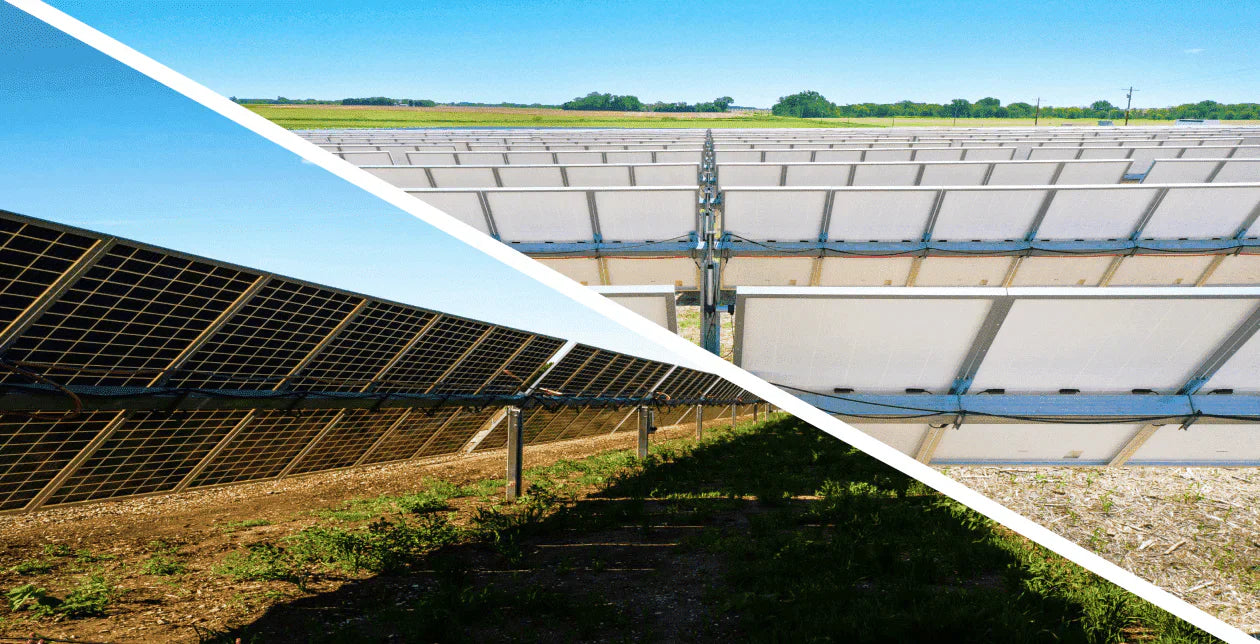
Which Solar Panel Is Best: Bifacial or Monofacial?
It can be difficult to decide whether to opt for monofacial or bifacial solar panels, especially given the long-term impact of any energy-investment decision.
Each has its advantages, but the best fit depends on your type of installation, budget and energy goals. Below, we’ll dive into the details of how these panels operate, where one set outperforms the other, and which type is right for your project.
Bifacial vs Monofacial Solar Panels: Key Differences
The way they capture sunlight differs significantly.
-
Monofacial panels capture sunlight from one side only and are more suitable for regular rooftop installations.
- Bifacial panels, meanwhile, produce power from the front and back by collecting reflected light, for instance from surfaces of concrete or white roofs. This two-sided design may raise total energy yield, depending on ground reflectivity and tilt angle, by a factor of 10-20%.
This distinction affects efficiency as well as installation approach, price and returns.
What Is a Monofacial Solar Panel and How Does It Work?

Monofacial solar panel is the conventional single-sided solar module which adopts technologies such as Mono-PERC or TopCon. It accumulates sunlight directly on the surface and converts it into electricity by photovoltaic elements.
These panels are reliable, widely available, and generally more affordable, which is why they remain the standard choice for residential rooftop systems.
When Should You Choose a Monofacial Solar Panel?
Monofacial panels are ideal if:
-
You have limited roof space.
-
There are no mirrored surfaces in your installation site.
-
You prefer lower upfront costs.
- You want a basic, inexpensive solar array that just keeps going.
For homes, and small businesses monofacial modules will often be the better balance between cost and output.
What Is a Bifacial Solar Panel and How Does It Work?
A bifacial solar panel that generates energy from either side. When reflecting sunlight on its rear side (known as rear-side irradiance gain), this effect can increase energy yield dramatically.
The secret to bifacial efficiency is something called the albedo effect - how much sunlight bounces off the ground. Surfaces, such as concrete, white roofs or light-colored gravel further reflect this additional production improving the panel’s performance.
HJT and n-type TOPCon, If it is HJT or n-type TOPCon, it significantly improves the reliability of bifacial modules while maintaining high efficiency even under harsh conditions.
When Is a Bifacial Solar Panel the Better Choice?
Bifacial solar panels are great for:
-
Ground-mounted installations or open spaces.
-
Commercial and industrial, where reflectivity and spacing can be varied.
-
High-light or low-shaded sites.
- Installations with variable inclination and reflective base.
In such conditions, that rear-side energy contribution and thus the bifaciality factor can make them up to 30% more productive than monofacial modules.
Cost Comparison: Bifacial vs Monofacial Solar Panels
Bifacial panels do cost more per watt to install, but the Levelized Cost of Electricity (LCOE) can be lower; over time. That’s because their greater output helps make up for the initial price.
But if your layout won’t accommodate correct rear exposure or reflective ground, the benefits may not be worth it. On smaller rooftops, monofacial panels can also provide better value for the money.
Which Solar Panel Is More Efficient: Bifacial or Monofacial?
In optimal conditions, bifacial panels provide higher efficiency than monofacial as the dual-sided generation is significantly more efficient, along with improved temperature resistance. Bifacial’s Capacity Utilization Factor (CUF) can go up to 80-90% of the theoretical energy, depending on tilt, location and reflectivity.
But in shadier or non-reflective installations, this benefit diminishes making monofacial panels a better option.
How to Decide: Bifacial or Monofacial for Your Rooftop or Ground Installation

When deciding between bifacial or monofacial solar panels, consider:
-
Installation Type: Rooftop or ground-mounted.
-
Surface Reflectivity: White roofs, gravel, or concrete improve bifacial gain.
-
Budget: Monofacial systems are more affordable upfront.
-
Long-Term Goals: If you aim for higher yield and scalability, bifacial panels may be worth the investment.
At Direct Solar Power, we help homeowners and businesses choose the right solar technology that balances cost, efficiency, and performance.
Conclusion
Both bifacial and monofacial panels have unique advantages. If you want a proven, cost-effective solution for a compact area, monofacial panels are a great choice. But if your goal is maximum efficiency and you have space for optimized setup, bifacial panels deliver higher returns in the long run.
Explore our collection of Bifacial Solar Panels and take the next step toward a sustainable future with Direct Solar Power.
Frequently Asked Questions
1. Which is better: a bifacial or a monofacial solar panel for a rooftop?
For rooftops, monofacial panels usually perform better due to their cost-effectiveness and simpler installation.
2. Do bifacial solar panels always produce more energy than monofacial ones?
Not always, it depends on ground reflectivity, tilt, and spacing. In optimal conditions, bifacial panels can generate up to 20-30% more power.
3. Are bifacial solar panels worth the extra cost compared to monofacial panels?
Yes, for large-scale or ground-mounted systems where reflective surfaces enhance performance.
4. What installation conditions make a bifacial solar panel advantageous over a monofacial?
Bifacial panels excel in open areas with high albedo surfaces like concrete or sand, where both sides can capture sunlight.
5. What are the maintenance and lifespan differences between monofacial and bifacial solar panels?
Both have similar lifespans (25+ years). However, bifacial panels require periodic cleaning on both sides to maintain performance.

Leave a comment